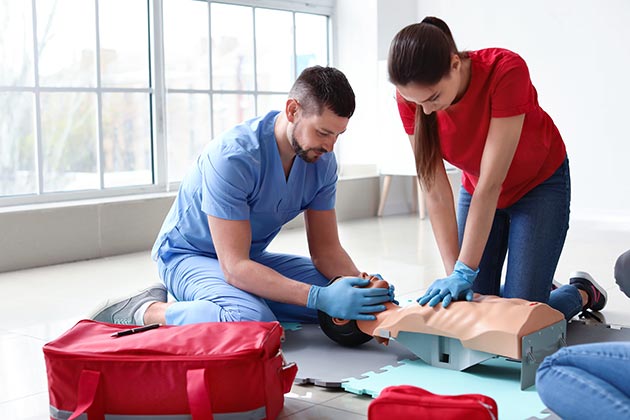
Unexpected emergencies might happen at any time. It can make the difference between life and death to know how to react in these dire circumstances. This is where learning Cardiopulmonary Resuscitation (CPR) and First Aid comes in, making regular people into heroes. This article will discuss the importance of learning CPR and First Aid, the fundamentals of these life-saving skills, and why everyone needs to start down this path.
Table of Contents
The Importance of Learning CPR and First Aid
When confronted with a medical crisis or an accident, the actions taken in the first few minutes are often the most critical. CPR and First Aid are invaluable for several reasons:
Immediate Response
CPR and First Aid equip you with the skills to respond promptly when someone’s life hangs in the balance. Whether it’s a sudden cardiac arrest, choking incident, or a severe injury, your swift actions can be the deciding factor.
Preventing Further Harm
First Aid plays a pivotal role in stabilizing the condition of an injured or unwell individual, preventing it from deteriorating while awaiting professional medical assistance. Properly administered First Aid can minimize the risk of complications.

The Basics of CPR
CPR, also known as cardiopulmonary resuscitation, is a life-saving procedure used to revive someone whose heart has stopped beating. Here is a step-by-step instruction sheet for CPR:
Step 1: Assess the Situation
The initial step in administering CPR is to assess the situation. Ensure the environment is safe for both you and the victim. Check if the person is conscious and breathing.
Step 2: Call for Assistance
If the individual is unresponsive and not breathing normally, call 911 or instruct someone nearby to make the call for professional medical help.
Step 3: Commence Chest Compressions
- Place the heel of your hand at the center of the person’s chest, just below the nipple line.
- Interlock your fingers and maintain straight arms.
- Position yourself so that your shoulders align directly over your hands.
- Administer firm and rapid compressions, aiming for a rate of 100-120 compressions per minute. Allow the chest to fully rebound between compressions.
Step 4: Administer Rescue Breaths
- After 30 chest compressions, provide two rescue breaths.
- Gently tilt the person’s head backward to open the airway.
- Pinch the person’s nose and cover their mouth with yours to create an airtight seal.
- Deliver a one-second breath that visibly raises the chest.
- Repeat this cycle of 30 compressions followed by two rescue breaths.
Step 5: Continue Until Help Arrives
Continue performing CPR until professional assistance arrives or until the person displays signs of life. It is crucial to persist, even if fatigue starts to set in.
Why Learning CPR and First Aid Matters (H2)
Empowering Bystanders
One of the primary reasons why everyone should learn CPR and First Aid is the potential to empower bystanders. In many emergency situations, the initial responder is not a medical professional but a concerned bystander. With CPR and First Aid training, you can be that composed and capable individual who takes charge of the situation.
Immediate Action
Time is of the essence during a medical emergency. The moments before professional aid arrives can be critical. CPR and First Aid training furnish you with the skills to provide immediate assistance, thereby increasing the odds of survival.
Confidence in Crisis
Your confidence in daily life can be boosted by being adept at handling emergencies. Your confidence in your capacity to handle unpredictable circumstances, whether they arise at home, at work, or in public, will increase.
Conclusion
In conclusion, learning CPR and First Aid is more than just picking up new abilities; it’s about setting out on a valiant quest where you might be able to save lives. You become a crucial link in the chain of survival when you become proficient in CPR and first aid. Your prompt action and knowledge could be a person in need’s lifeline. As a result, taking the initiative to learn these essential skills is both a responsibility and a chance to save the day.
CPR and First Aid can turn regular people into lifesaving heroes in times of need.These skills transcend age, gender, and background, making them accessible and crucial for everyone. Don’t be afraid to sign up for a CPR and First Aid training or brush up on what you already know because being prepared can mean the difference between life and death.
Never forget that you have the ability to save a life. You’ll be well on your way to being a true hero if you seize the chance to learn CPR and First Aid.






